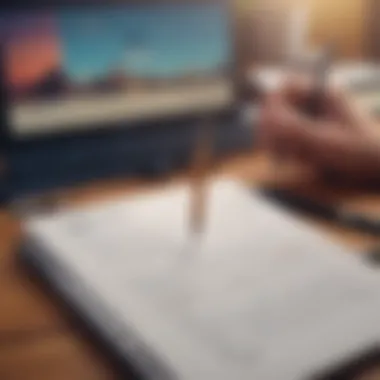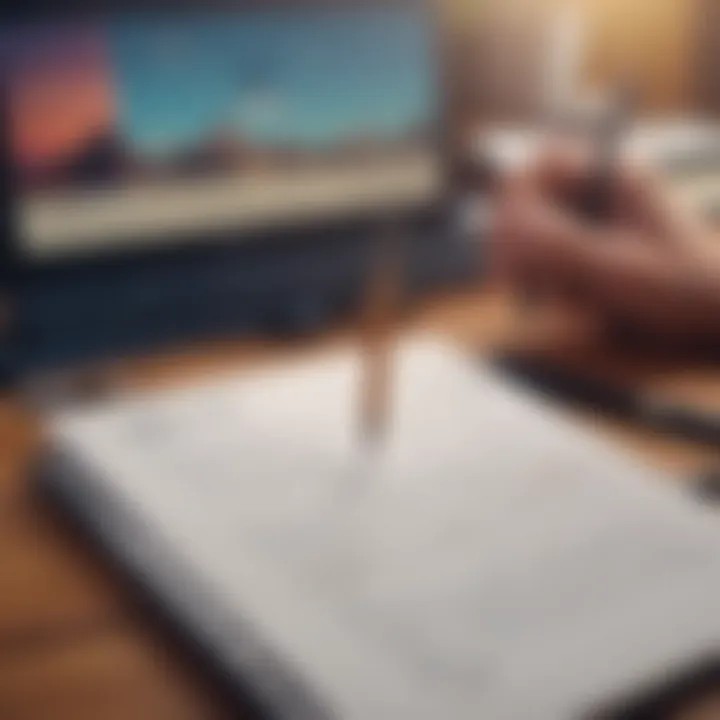Mastering Smart Note-Taking for Effective Learning


Intro
In today's fast-paced world, where information bombards us from every angle, mastering the art of note-taking can feel like trying to catch smoke with your bare hands. Yet, the ability to distill essential knowledge into digestible notes is a skill that can significantly enhance our educational journey. Smart note-taking isn’t merely jotting down what you hear or read; it involves a strategic approach to capturing thoughts, ideas, and concepts in a way that promotes understanding and retention.
This guide endeavors to explore the nuances of effective note-taking methods, offering insights and practical steps for students, professionals, and educators aiming to elevate their learning skills. By shedding light on various techniques, tools, and best practices, readers will be well-equipped to transform their learning experiences into something more structured and rewarding. The journey through this guide will uncover not just how to take notes, but how to turn these notes into vital resources that can stand the test of time.
Key Concepts and Insights
Main Ideas from the Book
One pivotal aspect of smart note-taking revolves around tailoring your notes to fit your learning style. Some people are visual learners, thriving on diagrams and charts, while others excel with written elaboration or verbal summaries. This means the first step is to identify what works best for you.
Effective note-taking can break down into several core principles:
- Active Engagement: Being present and actively participating during lectures or while reading increases retention significantly.
- Organization of Information: Structuring notes in an organized manner distracts less and highlights crucial aspects easily. Techniques like the Cornell method or mapping can be immensely beneficial here.
- Use of Keywords: Summarizing topics with keywords helps in quick revisions later on without sifting through lengthy paragraphs.
Practical Applications of Concepts
The beauty of these concepts is in their practical application. For instance, harnessing the digital age through apps like Notion or Microsoft OneNote allows for flexibility and multimedia incorporation. You can mix texts, images, and sounds depending on what helps you absorb the material.
Moreover, here are some practical tactics to implement:
- Color Coding: Assign different colors to various topics or themes within your notes to facilitate easy navigation.
- Symbols and Abbreviations: Develop a personal shorthand to speed up note-taking and keep up with fast-paced lectures.
- Periodic Reviews: Regularly revisiting your notes strengthens recollection, turning fleeting memories into lasting knowledge.
"The capacity to learn is a gift; the ability to learn is a skill; the willingness to learn is a choice." – Brian Herbert
Recommendations and Further Reading
If you're looking to delve deeper into the realms of note-taking and learning strategies, the following resources could prove invaluable:
Related Books to Explore
- "Make It Stick: The Science of Successful Learning" by Peter C. Brown - A great read on practical techniques based on cognitive science.
- "The Study Skills Handbook" by Stella Cottrell - This book offers a broad spectrum of study strategies that can significantly elevate learning effectiveness.
Additional Resources for Personal Development
- Wikipedia on Note-taking - A comprehensive background on different note-taking styles and methodologies.
- Reddit: StudyTips - A vibrant community sharing experiences and tips.
By incorporating smart note-taking strategies into your routine, you can shift the learning paradigm from passive absorption to active engagement. As you embrace these techniques, learning becomes less of a chore and more of an enlightening journey.
Preamble to Smart Note-Taking
Smart note-taking is more than just jotting down information; it’s about fostering a deep connection with the material being learned. In today’s fast-paced world, where the volume of information is staggering, it’s vital to adopt techniques that enhance not just how we record what we learn but also how effectively we can recall and apply that knowledge later.
Definition of Smart Notes
Smart notes can be understood as thoughtfully created and structured snippets of information that help to reinforce learning. These notes are often distinguished by their clarity and purpose. Unlike traditional notes that may mirror what the speaker has said or what’s present in a textbook, smart notes encourage the individual to distill the essence of the material. This may involve paraphrasing key concepts, summarizing discussions in one’s own words, or even drawing connections to other topics.
By leveraging various methods—such as the Cornell Method, mind mapping, or even digital tools like Notion and OneNote—learners can craft notes that not only summarize information but also evoke personal insights and questions, bringing a new layer of understanding.
Importance in Learning
The significance of smart note-taking cannot be understated; it works as a gateway to enhanced learning potential. With effective note-taking, learners can experience numerous benefits:
- Improved Retention: Writing information in your own words helps to solidify the knowledge in your memory. It transforms passive listening or reading into an active engagement process.
- Easier Review: Well-structured notes are easier to revisit and comprehend. Instead of sifting through scattered thoughts, learners can quickly pinpoint essential ideas and their interrelations.
- Enhanced Critical Thinking: Smart note-taking often requires analyzing and synthesizing information. When individuals engage in this thought process, they develop critical thinking skills that are invaluable in both academic and professional settings.
- Increased Engagement: As one actively takes notes, there’s a natural rise in interest towards the content being presented. This engagement can lead to an enhanced understanding, as learners are not just passive recipients of information.
"The act of rewriting and visualizing concepts in notes can transform a mundane lecture into a rich learning experience, allowing for deeper comprehension and retention."
By emphasizing these aspects, we can understand why focusing on smart note-taking is not just about academic success but is crucial for lifelong learning. The next sections will unravel distinct principles of effective note-taking, guiding readers on creating notes that not only serve as a study aid but also contribute to their overall learning journey.
Principles of Effective Note-Taking
Effective note-taking is like building a solid foundation for a house. It holds everything together and makes learning more structured and accessible. This section dives into three core principles: clarity and conciseness, organization of information, and active engagement with content. Each plays a crucial role in transforming mere notes into powerful tools for understanding and retention. This approach will help students and professionals alike maximize their learning experience.
Clarity and Conciseness


When it comes to note-taking, clarity is key. Notes should be straightforward and devoid of unnecessary fluff. Imagine trying to decipher a tangled web of words — sounds frustrating, doesn’t it? Keeping your notes clear cuts through the clutter. Aim for short, impactful sentences that communicate ideas without extra baggage. Conciseness doesn’t mean being vague; rather, it’s about getting to the point swiftly. For instance, instead of writing, "The concept of photosynthesis involves plants converting sunlight into energy through a process that requires water and carbon dioxide," one might say, "Photosynthesis: plants turn sunlight into energy using water and CO2."
This transition from long-winded explanations to succinct statements not only saves time but also enhances comprehension. By focusing on crucial points, the brain can remember and review information more efficiently. It's about clarity being the backbone of effective learning.
Organization of Information
Now that clarity sets the stage, let’s talk about organization. Think about a messy desk filled with just about everything; finding that one important piece of paper would be nearly impossible. The same goes for notes. If they’re disorganized, utilizing them becomes a challenge. The goal is to create a format that categorizes information logically, making it easy to follow.
There are various methods to organize notes. For instance:
- Headings and subheadings can create a hierarchical flow, guiding the reader through the material.
- Bullet points help highlight key ideas without wading through paragraphs.
- Numbered lists are great for sequences and timelines that need to be followed step-by-step.
Using tools like outlines can also streamline the review process later on. A well-organized set of notes can make all the difference, making the information easily gripable, much like flipping through a well-arranged library.
Active Engagement with Content
Last but not least, active engagement transforms note-taking from a passive activity into an interactive learning experience. It’s about diving deep into the subject matter rather than skimming the surface. To engage proactively, students should paraphrase concepts in their own words and ask questions as they write. This practice reinforces comprehension and retention.
Even adding personal insights or examples can bolster the connection with the material. Instead of merely jotting down facts, think about how the information fits into what you already know. For example, when learning about economic theories, consider how they relate to real-life scenarios or current events. This bridge between theoretical knowledge and practical implications makes it easier to recall information later.
Methods of Smart Note-Taking
In the realm of learning, the methods we choose for note-taking can dramatically shape our understanding and retention of new information. Effective note-taking isn't just about capturing words on paper or screen; it embodies a structured approach to assimilating knowledge. By utilizing smart note-taking methods, learners position themselves not just to remember the material, but to engage with it on a deeper level. Let’s explore some prominent methods of smart note-taking and their unique features.
The Cornell Method
The Cornell Method, developed by Walter Pauk at Cornell University, is not merely a technique; it’s a systematic approach that separates the chaos of notes into manageable chunks. In this method, the paper is divided into three sections: a narrow column on the left for cues, a wider column on the right for notes, and a summary section at the bottom. This layout encourages active engagement. As one attends lectures, key points are jotted down in the larger right-hand column. Afterward, students can prompt their recall by using the cues written in the left column as a mini quiz.
- Benefits of the Cornell Method:
- Enhances memory retention through effective review.
- Encourages critical thinking as it requires synthesizing information rather than just transcription.
- Provides a clear, structured layout that can be easily navigated during revisions.
This method emphasizes the importance of summarization, transforming notes into a tool for reflection. The act of condensing notes into a summary enables learners to grasp the essence of lectures more efficiently.
Mind Mapping Techniques
A mind map is a visual representation of concepts and their connections, which operates on the principle that our brains naturally organize information in this way. Mind mapping is less about linear note-taking and more about creating a vibrant, visual tapestry of ideas. Starting with a central concept, learners branch out to related topics, subtopics, and details. This non-linear method is effective for complex subjects where relationships between concepts are pivotal.
- Key aspects of mind mapping:
- Visual Learning: Perfect for visual learners as it combines symbols and colors.
- Engagement: Keeps the mind engaged, preventing monotony associated with conventional notes.
- Creativity: Encourages creative thinking, making connections that might not be immediately obvious.
Mind maps also facilitate brainstorming sessions, allowing ideas to flow freely without the constraints of strict organization.
Outline Method
The Outline Method is often praised for its structured, hierarchical format which breaks down a subject into its components. Using bullet points and indentations, the main ideas are listed first, followed by supporting details. This method works exceptionally well for subjects that are logical and structured, such as sciences and humanities.
- Advantages of the Outline Method:
- Simplifies complex information by organizing it in a logical flow.
- Makes it easy to identify the relationship between main ideas and supporting facts.
- Facilitates quick reviews, as key points are easily scannable.
One downside is that it might not cater well to subjects requiring extensive elaboration on ideas or creative thought processes. Yet, for many learners, the clarity that comes from this method is invaluable.
Ultimately, the method that resonates most with a learner often depends on their individual preferences and the nature of the material being studied. By experimenting with these methods, learners can uncover the most effective strategies for their unique learning journeys.
Digital Tools for Note-Taking
In today’s fast-paced and information-rich environment, note-taking has evolved into a more dynamic process, with digital tools making a significant impact on how we capture, organize, and retrieve information. Embracing these tools is a game changer, particularly for students, professionals, and educators who aim for efficiency and effectiveness in their learning practices. The importance of digital note-taking tools lies not only in their ability to streamline the note-taking process but also in their capacity to enhance retention and understanding of the subject matter.
Note-Taking Applications Comparisons
There’s a smorgasbord of note-taking applications available today, each with unique features that cater to a range of needs. When comparing these applications, you might want to look at factors like functionality, ease of use, and compatibility with other systems:
- Evernote: Renowned for its organizational capabilities, Evernote allows you to create and store notes in notebooks and tags, making information retrieval a breeze.
- Microsoft OneNote: This app provides a freeform canvas for note-taking, supporting both text and multimedia, making it versatile for various types of content.
- Notion: Notion stands out with its collaborative elements, as it integrates project management and note-taking in one platform, appealing to teams and individuals alike.


Each application comes with its pros and cons, so discerning the right fit for one’s style can lead to a more personalized, effective note-taking experience.
Cloud-Based Solutions
Cloud-based note-taking solutions bring a layer of convenience that traditional methods simply can't match. By storing notes online, these solutions offer accessibility across multiple devices. Whether you're on your phone during your commute or sitting at a computer, your notes are just a click away. This flexibility is especially critical when deadlines loom large and access to information is urgent. Furthermore, cloud-based tools often come with robust security features, ensuring that your notes remain private and protected from unauthorized access.
But it’s not just about access; collaboration becomes more manageable too. As many of these tools allow sharing and real-time editing, teamwork becomes seamless, reducing communication barriers. This is crucial, particularly in academic settings or in collaborative projects within professional environments.
Integrating Multimedia Elements
Incorporating multimedia elements in note-taking isn’t merely a trend; it significantly enriches the learning experience. Images, videos, and even audio recordings can bring context to your notes, allowing for a more thorough understanding of the topic. Here’s how multimedia can make a difference:
- Visual Aids: Diagrams, charts, and images can help clarify complex concepts that may be less engaging in text-only format.
- Audio Notes: Recording lectures or discussions enables selective focus on specific sections later, capturing nuances that typical written notes might miss.
- Video Links: By embedding relevant videos in your notes, you can create a comprehensive resource that links theoretical understanding with practical application.
"The beauty of digital notes is their versatility; you can combine text with images and audio to create a rich information repository."
Whether you are a visual learner or prefer auditory input, effectively blending these elements can cater to diverse learning styles, fostering deeper engagement and comprehension. As the landscape of learning changes, being adaptable and embracing digital tools becomes essential for anyone aiming to excel.
Physical vs Digital Notes
The debate between physical and digital notes has been around for quite some time, and it's not just a matter of preference but also one of practicality and effectiveness. Each method has its own set of advantages and challenges that cater to different learning styles and objectives. Understanding these aspects can significantly impact how we absorb and retain information.
Comparative Advantages
Physical notes, often written by hand, have a unique quality that many students find invaluable. Research suggests that writing by hand helps in encoding information more deeply, ultimately aiding memory retention. Here are some of the benefits of physical note-taking:
- Tactile Experience: The act of writing engages more senses. When you put pen to paper, it feels distinct, and making notes by hand can enhance focus and mindfulness.
- Flexibility in Format: You can quickly doodle, draw arrows, or highlight important points. This informal structure often leads to a more personal connection with the material.
- Less Screen Fatigue: In a world overloaded with digital devices, many people appreciate stepping away from the screen, finding that physical notes allow the mind to breathe.
On the flip side, digital notes are not without their merits. They offer some options that physical notes simply can’t match:
- Search Functionality: Digital tools allow users to find information at the click of a button. Highlighting and searching keywords can be a significant advantage, especially when reviewing large amounts of content.
- Cloud Storage and Accessibility: Having notes stored in the cloud means you can access them from any device, which makes studying more flexible and convenient. This is particularly beneficial for those who travel frequently or attend classes in different locations.
- Integration with Multimedia: Digital notes can incorporate images, videos, and hyperlinks that enrich the learning experience. These interactive elements can make studying feel more engaging.
Personal Preferences and Learning Styles
When it comes to choosing between physical and digital notes, personal preferences and learning styles play a critical role. For instance:
- Visual Learners: Often benefit from the various formats available in digital note-taking applications, such as rich text formatting and the incorporation of visuals. Tools like Notion or Microsoft OneNote let them arrange information in an appealing format.
- Kinesthetic Learners: May find that writing notes by hand fosters a deeper connection to the material. They often prefer the physicality of inline drawings and handwritten notes over typing.
- Auditory Learners: Might prefer to use digital tools to capture spoken lectures, as many applications allow for audio recording back to text, enabling a full-circle learning experience.
Ultimately, the choice between physical and digital notes comes down to what works best for you. It might be beneficial to experiment with both methods, observing how each impacts your retention and understanding of the material.
"Learning styles are about harnessing your way of learning, not limiting it."
Adapting note-taking methods to suit your style can lead to a more effective educational journey.
Common Challenges in Note-Taking
Note-taking plays a vital role in learning, yet mastering it is not without hurdles. Addressing common challenges in note-taking helps learners identify the obstacles that can hamper their understanding. Recognizing these pitfalls is the first step towards overcoming them, ultimately leading to more effective study habits. Here, we delve into some recurring issues that learners face, alongside strategies to tackle them.
Overwhelming Amount of Information
In today’s information-heavy age, the sheer volume of content presented in lectures, readings, or online courses can be staggering. Students often find themselves inundated, struggling to distinguish between essential points and supplementary details. This information overload can lead to frustration, where learners feel they are drowning in notes, unable to recall critical concepts when needed.
"In the sea of knowledge, often the most valuable pearl gets lost."
To combat this, it's crucial to develop filtering skills. Here are some strategies that can be helpful:
- Prioritize key themes: Focus on grasping overarching ideas rather than transcribing every word.
- Use symbols or shorthand: Develop a personal shorthand system to speed up note-taking and emphasize important information.
- Summarize concepts: After a lecture, summarizing key points in your own words helps to cement what you've learned and reduces the bulk of your notes.
Loss of Focus During Lectures
Sitting through lengthy lectures can test anyone's attention span. Even the most captivating speaker can lose their audience if the content is heavy or ideas are delivered in a monotonous manner. With the distractions of smartphones and wandering thoughts, staying engaged is a challenge many students encounter.
Tips to maintain focus include:
- Pre-lecture preparations: Familiarize yourself with the lecture topic beforehand. This helps keep you engaged since you’ll be primed to absorb new information.
- Active listening: Instead of just passively writing what is said, try to engage with the material, jotting down questions or ideas that come to mind.
- Switching note-taking formats: Occasionally, changing how you take notes can rekindle your focus. Try mind-mapping or color-coding to keep your interest piqued.


Difficulty in Review and Retrieval
Creating notes is only half the battle; the other half lies in reviewing them effectively. Many students find themselves flipping through pages, looking for that golden nugget of information only to come up empty-handed. When notes are disorganized or lack a coherent structure, retrieving that information becomes a daunting task.
To enhance review and retrieval:
- Organize your notes: Whether by date, topic, or genre, a clear structure is essential for quick reference.
- Regularly review your notes: Implement a routine of revisiting your notes after each class to reinforce memory retention.
- Employ active recall: Test yourself on the material. Try to recall key concepts without looking at your notes, which strengthens memory pathways.
Post-Note-Taking Strategies
Post-note-taking strategies hold a pivotal role in the learning continuum, emerging as the bridge between mere note collection and effective knowledge integration. It’s not enough to jot down thoughts and insights in a hurry; the real trick lies in what happens next. A structured approach to reviewing and connecting ideas can transform those notes from passively recorded information to active building blocks of understanding.
Review Techniques
Reviewing notes isn’t just a mindless repeat of what was written down. Think of it like revisiting an old friend; you discover nuances upon re-engagement that you might’ve missed in the first encounter. Here are some techniques that can improve this essential stage of learning:
- Spaced Repetition: Instead of cramming, spread out your review sessions. This taps into the psychological spacing effect, helping you retain more.
- Summarization: After reading through notes, summarize key ideas in your own words. This reinforces comprehension and highlights what’s truly important.
- Flashcards: Use them to create questions from your notes. It turns passive recognition into active recall, sharpening memory.
- Discussion: Find a peer and discuss your notes. Explaining concepts to others can deepen your own understanding and reveal gaps in knowledge.
Research suggests that the more you engage with your notes post-creation, the stronger your recall will be. Each method can be tailored to fit individual learning styles, ensuring that the strategies resonate on a personal level.
Connecting Ideas for Deeper Understanding
Once the reviewing is done, the next step is to weave together the concepts scattered throughout your notes. Here’s why this is crucial: it’s the connections you make that often lead to breakthroughs in understanding.
- Mind Mapping: Create visual representations of relationships between topics. This is especially useful when tackling complex subjects. A mind map could take a single lecture and show how ideas interconnect, possibly leading to new insights.
- Thematic Grouping: Cluster notes by theme rather than chronologically. By grouping similar concepts, you can see the bigger picture, enhancing comprehension.
- Ask Why: Delve deeper into your notes by asking why something works the way it does or the implications it holds. This inquiry fosters an investigative mindset, crucial for critical thinkers.
"Connecting ideas isn’t just about understanding; it’s about applying knowledge in innovative ways."
Through these strategies, learners can take charge of their educational journey, turning chaos into order. As you connect ideas, you not only solidify what you’ve learned but also prepare to apply it in real-world scenarios, enriching both personal and professional growth. Embracing these post-note-taking strategies can lead to an enriching educational experience, ensuring that notes become resources for future reference rather than artifacts of a past lecture.
The Role of Smart Notes in Personal Development
Smart notes go beyond mere record-keeping; they play a transformative role in personal development, intertwining with our ability to think critically and embrace lifelong learning. As we delve into this essential aspect, it's crucial to appreciate how the act of taking notes can foster growth in various dimensions of our educational journey.
Enhancing Critical Thinking Skills
Taking smart notes helps sharpen one's critical thinking. When we jot down information, we are not just transcribing what we hear or read; we engage with the content actively. This engagement demands that we analyze, compare, and contrast ideas, which in turn enriches our cognitive skills.
- Analyzing Information: When recording information, often we need to break it down into smaller parts for clarity. This process of analysis compels us to consider the validity of the information and its implications.
- Questioning Assumptions: With smart notes, it's easier to jot down questions that arise while learning. These questions are crucial as they foster deeper inquiry, pushing us to seek out more information beyond the surface level.
- Synthesizing Ideas: Smart notes encourage the synthesis of various concepts. When different ideas are laid out systematically, it allows us to see connections, relationships, and patterns that might have gone unnoticed. This kind of synthesis nurtures creative thinking—an invaluable skill in any field.
Moreover, making connections among diverse subjects enhances our ability to approach problems from myriad angles, enriching our overall understanding.
Facilitating Lifelong Learning
In an ever-changing world, continuous learning is no longer a luxury but a necessity. Smart notes facilitate this ongoing education in several ways:
- Flexible Review: Smart notes can be organized in a way that allows easy revisiting. This constant access to information not only aids memory retention but also promotes a habit of regular review, which is vital for long-term retention.
- Personal Reflection: Writing notes isn’t just about recording what’s taught; it allows individuals to reflect on their own understanding and experiences. This reflection can guide future learning paths and help tailor them to personal interests and goals.
- Resource Development: By maintaining a well-organized set of notes, learners create a resource bank that they can turn to for future projects and discussions. This decentralized knowledge is a powerful catalyst for self-directed learning, encouraging exploration beyond traditional education constructs.
- Building a Learning Community: The digital age offers many platforms where smart notes can be shared—think forums like reddit or social networks like Facebook. Sharing insights and notes not only builds a sense of community but also enhances the learning experience through collaborative discussion.
"Smart notes are not just a study tool; they're an investment in your future learning and growth."
Ultimately, mastering the art of smart note-taking equips individuals with tools to foster independent exploration and continuous growth. By enhancing critical thinking and embracing lifelong learning, smart notes become essential allies in navigating the intricate landscape of knowledge.
Epilogue: Cultivating Effective Note-Taking Habits
The essence of effective note-taking cannot be overstated. It’s a pivotal aspect of learning that transforms the way we absorb and recall information. This article emphasizes the need for cultivating robust note-taking habits because, without them, even the most brilliant insights may slip through one's fingers like sand. Learning is not a singular event; it’s an ongoing journey, and taking smart notes paves the way for continuous improvement and deep comprehension.
Summary of Key Points
Throughout this guide, the spotlight has been on various approaches to smart note-taking, each designed to enrich understanding and bolster retention of information. Here’s a recap of what we’ve discovered:
- Definition of Smart Notes: Smart notes are not merely a collection of facts or ideas but an organized system that promotes deeper understanding of material.
- Principles of Effective Note-Taking: Clarity, conciseness, and active engagement are fundamental in any note-taking endeavor.
- Methods of Smart Note-Taking: Techniques such as the Cornell Method, mind mapping, and outlines can be instrumental to cater to diverse learning styles.
- Digital Tools: Many applications support note-taking, allowing for seamless integration of multimedia and information sharing.
- Challenges and Strategies: Recognizing obstacles and employing effective post-note-taking strategies bolster information recall.
- Personal Development: The integration of smart notes into personal and professional growth enhances critical thinking and fosters lifelong learning.
In essence, mastering these points allows you to approach learning with a well-equipped toolkit.
Encouragement for Continued Improvement
As you venture forth in this pursuit of knowledge, remember to treat your note-taking practice as a craft to refine. It’s not sufficient to simply jot down thoughts; the aim should be to make each stroke of the pen or keystroke count. Embrace the imperfection of learning. Just as a sculptor chisels away to reveal form, so, too, can you shape your notes into a polished work of understanding.
- Reflect on Your Techniques: Regularly assess whether your current methods work for you. Don't hesitate to adapt or even adopt new strategies if needed.
- Seek Feedback: Engaging with peers about your notes can provide a fresh perspective. Sharing can enhance the learning experience for everyone involved.
- Embrace Experimentation: Dive into different tools or techniques and find what resonates. Sometimes, straying from the routine can yield unexpected insights.
In this world of information overload, don’t let your learning retreat into chaos. Consistency in practice and a willingness to improve will inevitably shape your note-taking effectiveness. Smart notes are not merely a learning aid; they are a proven pathway to revealing deeper connections and greater understanding in your academic journey and beyond.
The key to effective learning lies in translating chaos into clarity, one note at a time.







